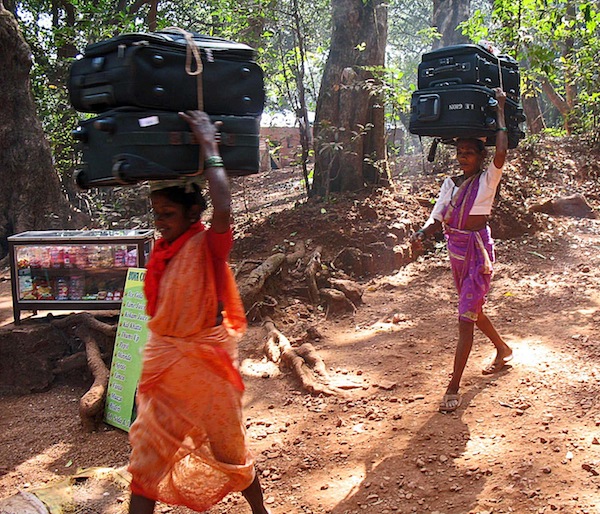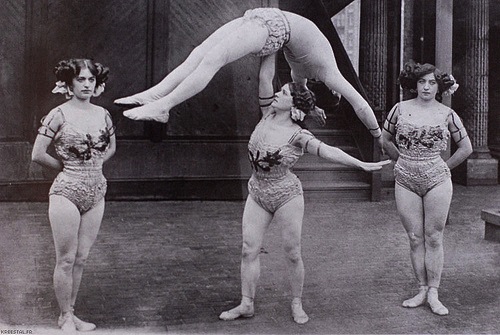How Much Weight Should You Lift?
In a region of northern Morocco, there is a border crossing to the Spanish-held territory of Melilla. Thousands of pounds of goods travel back and forth between these two countries every day — and much of it on the backs of women.
 Women — some pregnant or injured, many divorced and single mothers, the sole earners for their families — carry loads of up to 80 kg (175 lb) on their backs, back and forth across the borders, often 3 or 4 times a day.
Women — some pregnant or injured, many divorced and single mothers, the sole earners for their families — carry loads of up to 80 kg (175 lb) on their backs, back and forth across the borders, often 3 or 4 times a day.
This archaic form of human transport is done so that the women do not have to pay import taxes: Anything you can carry on your body across the border is free.
They’re paid by the pound, so women carry as much as they can stagger beneath. For one trip, a carrier might make around $3-4 US. (For more on this, see BBC World.)
I begin with this story to illustrate a point: Middle-class North American ideas of what women “should” be doing have no basis in physiological reality.
In other words, we are told by “celebrity fitness trainers” and fluffy “fitness” magazines that women “should” only lift a few pounds at most.
And that is total. Bullshit.

Mary, a Moroccan goods transporter, is a breast cancer survivor who uses a crutch after a leg injury. Oh, and she hauls hundreds of pounds a day.
Grrls, there’s a woman with breast cancer and a crutch hauling the equivalent of a dead body on her back across Morocco right now.
Now, I’m not saying this to celebrate a glorious way of life where we all make our livings being human pack mules. And learning about the existence of a disabled breast cancer survivor doing heavy manual labour kind of makes my soul shrivel a little bit.
But nevertheless, the point is that our expectations about what “too heavy” is for women… are probably wrong.
Women, your body is a fucking magical machine. Truly.
In terms of their loading strength, bones are stronger than steel. Think about it — there are people who weigh a few hundred pounds walking around on what are basically skinny sticks stuck together with a few straps of protein. Each step produces thousands of Newtons of force on the skeleton.
Now, it might not feel great to go for a stroll if you weigh 300-400 lb… but it can be done. Which is pretty fucking amazing.
Muscles are likewise goddamned incredible. Basically they’re hunks of meat wired up to a battery. But you can do a vast variety of things with them — from crocheting to punching to tap dancing.
So take a moment and just high-five your body for being an engineering marvel.
OK, so let’s talk about muscle force.

Weightlifters at the World’s Strongest Man Competition 2013 in rural China get owned by a middle-aged female farmer who stopped by and picked up their watermelon baskets that can weigh about 110 lb (about 50 kg) each. Sez she: “This is nothing. We do this all the time”.
|
What creates muscle force?
Muscles’ main job is to produce force. How much force they can produce depends on a few things.
Motor units
A motor unit is a nerve that is connected to some muscle fibres, like an electrical plug attached to an appliance.
The more motor units that get activated, the more force. Activation of motor units is also known as recruitment.
This is why big movements involving a lot of body parts (like a squat or press) build more muscle than small movements (like twiddling your thumbs). And why you can squat a lot more weight than your thumbs can twiddle.
After all, a bigger army is stronger than a tiny army. More recruitment, more force.
Muscle size
Bigger muscles are stronger muscles. They have more muscle fibres to activate.
Muscle length
Muscles are sort of like thick rubber bands. They store energy in their “stretch” before they snap back. So if the muscles are stretched a little (not a lot), they’re more powerful.
Joint angle
Force is about physics, and each movement has an optimal angle.
You probably know how difficult it is to grab a small object when you’re in an awkward position, such as twisting to reach something off a high shelf. In that case, your body angles are disadvantageous — you can’t produce much force.
But let’s say your body is arranged in strong angles — the shelf is right in front of you and you can reach straight forward to grab that thing. No problem; you can probably haul something pretty heavy off that shelf easily.
Think about trying to jump from a standing position. You don’t get much height. Now, squat down a little and try that jump. Much better!
Movements from a more advantageous position — where joint angles are biomechanically optimal — will be stronger.
Your unique structure
Each person is a little different in the arrangement of their bones and muscles.
Ever wondered why some people seem to be “naturally strong” even though they might be skinnier? One factor is that they might have more advantageous muscle attachments. A few millimetres of difference in terms of where muscles attach to bone can make a big difference when moving that bone.
For instance, think of a seesaw. Now think about how the load of the seesaw changes when the fulcrum is moved. If the fulcrum is closer to one end, the person sitting on the long end has to be a lot heavier to move the person on the short end. Similar idea with muscles.
If your muscles are attached more advantageously, you’ll be naturally stronger. Of course, even if your muscle attachments aren’t those of an Olympian, you can still get stronger for you. Everyone can get stronger with training.
Movement speed
Try to move the weight faster, and you’ll generate more force. This is true even if the weight isn’t actually moving fast. The point is the trying.
Telling your body to move the weight fast gives specific instructions about how, and how many, motor units to recruit. An order to “Haul ass now!!” creates a powerful muscular contraction. (As does yelling “BAM!“, as long as you don’t crack up.)
Great… so how much weight should I lift?
The point of this is that there is no “should”.
How much weight you’ll lift is unique to you, how you are, right now.
Your body. Your needs. Your skill level. Your abilities. Your individual combination of levers and force-producers. The specific movement you’re doing.
Heck, muscle force can be affected by what’s going on right this moment. Are you distracted? Getting your period? (Many women find that their strength ebbs and flows over their menstrual cycle.) Do you have a blister or tendonitis? Is your favourite song on the radio?

Strength is like a cat. It comes and goes on its own schedule. You might know why or how, and you might not.
So don’t get too worried about figuring it all out, or conforming to standards.
Expect that, with training, you might exceed your expectations. Or you might confront limitations you didn’t anticipate. Both are probably true at different times.
Stay patient and persistent. Don’t rush. Strength unfolds slowly, over time. Keep pushing and poking at it. Enjoy the journey.
Here’s what to do.
1. Start lighter than you think you should. Lift the weight.
2. How does it feel? Could you go a little heavier, safely and with good form? Great. Go a little heavier.
3. How did that feel? Could you go heavier, safely and with good form? Great. Go a little heavier.
4. Where are you at with that? How’s that landing for you? Would going heavier meet your goals right now?
a) Yes? Can you do it safely and sanely? Great. Go for it!
b) No? Cool, you’re done.
See? Easy!
Notice how this process is fresh. It’s a “right-now”, present-moment process.
You try stuff, see how it feels in that moment, decide whether it meets your goals or abilities for the day, and keep iterating.
If you want to get fancy, this is known as auto-regulation. You sense in to what is happening in your body at a given moment, and make decisions accordingly.
Some days you’ll show up and feel like crap. You’ll be weak and listless, and just want to lie down in the power rack for a nap. On those days, lift less. (Or, after 10 minutes, you might feel more energized. Pay attention and note how your body sense changes from moment to moment.)
Other days, you’ll show up to the gym and feel like a superstar. On those days, go “beast mode”. Be smart, intelligent, and careful… but not too careful. Take a little risk. Play. Push your limits a bit. See what happens.
And ditch the “rules”.
 |
Addendum
Greg Everett over at Catalyst Weightlifting has some great thoughts on how to approach choosing weights.
Essentially, work on technique and your foundation first, before pushing the load.
This will ensure that when shit gets real, your structure doesn’t lose integrity. (A good rule for life, too.)
Highlights:
Doing things properly and doing them heavily don’t have to be mutually exclusive endeavors.
Maximal efforts will certainly not look as perfect as sub-maximal lifts, but the more proficient you become at a given exercise, the less deviation you will see, and this is the goal because it means more success and less chance for injury.
That means performing the overwhelming majority of your reps properly — you learn what you practice, and you strengthen the movements you load.
The only people who need to push maximal effort lifts are more advanced athletes, especially strength athletes. The typical personal training client has no need to be approaching colon-prolapsing squat efforts.
The former group are experienced trainees who have well-established motor patterns and don’t deviate grossly from correct movements even when loaded heavily. The latter group are the ones who suddenly fall apart with an additional 5kg and look like they’ve never done a squat in their lives.
“Struggling” is good – you need to work hard to get stronger. But struggling means pushing hard, not falling apart.
So if by struggling you mean your client doesn’t just stand up with no effort, then that’s a good way to find a working weight; if you mean a squat starts looking like your client is trying to pop a soccer ball between his or her knees while in child’s pose, then that’s way beyond anything helpful.
